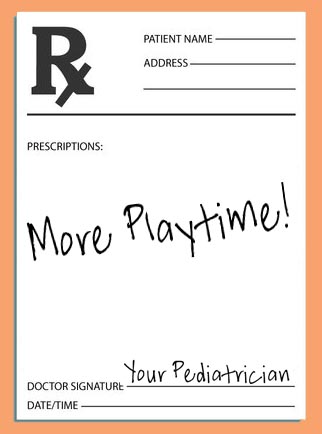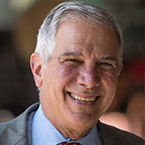By: Michael Yogman, MD, FAAP
More than just a chance to have fun, play is serious business when it comes to a child's health and development. From peek-a-boo to pat-a-cake and hide-and-seek to hopscotch, the many forms of play enrich a child's brain, body and life in important ways.
The American Academy of Pediatrics (AAP) clinical report,
The Power of Play: A Pediatric Role in Enhancing Development in Young Children, explains how and why playing with both parents and peers is key to building thriving brains, bodies and social bonds―all important in today's world. Research shows play can improve children's abilities to plan, organize, get along with others and regulate emotions. In addition, play helps with language, math and social skills, and even helps children cope with stress.
A prescription for play
 Despite its many benefits, statistics show that the amount of time children get to play has been declining for decades. Tightly structured family and school schedules, fewer safe places to play and rising
media use and screen time are among the reasons. To help keep play a key part of childhood, pediatricians may begin writing a "prescription for play" at every
well-child visit through age 2. Pediatricians also advise parents to look for
quality child care or preschool programs that include playful approaches to learning. Despite its many benefits, statistics show that the amount of time children get to play has been declining for decades. Tightly structured family and school schedules, fewer safe places to play and rising
media use and screen time are among the reasons. To help keep play a key part of childhood, pediatricians may begin writing a "prescription for play" at every
well-child visit through age 2. Pediatricians also advise parents to look for
quality child care or preschool programs that include playful approaches to learning.
|
Age-specific ideas for playful learning
Learning is best fueled by tapping into a child's natural urge to play, rather than just outside factors like test scores. As they actively engage with and joyfully discover their world, children gain 21st century skills that increasingly call for teamwork and innovation.
The AAP encourages parents to use play to help meet their child's health and developmental milestones, beginning from birth. Some examples of ways to do this:
Birth to 6 months old
Playful learning can start with a baby's
first smile. Responding with a smile of your own is a form of play that also teaches a baby a critical
social-emotional skill:
"You can get my attention and a smile from me anytime you want―just by smiling yourself."
Imitate your baby's coos and babbles and have back-and-forth "conversation" using your baby's sounds as a prompt. This sort of vocal turn-taking forms the basis of social language skills.
Show your baby interesting objects such as a brightly colored toy. Let them bring safe objects to their mouth to explore and experience new textures.
Place your baby in different positions so they can see the world from different angles. Supervised
tummy time play is great for this.
7 to 12 months old
Make sure your baby has a safe environment to crawl and explore.
Give your baby opportunities to learn that their actions have effects—for example, when they drop a toy and it falls to the ground. Put a few toys within reach of your baby so they can take toys out and play with them.
Use a mirror to show your baby their different facial expressions.
Play peek-a-boo. This reinforces object permanence, the idea that something still exists even if you can see it. You'll know your baby gets the idea if you hide a toy under a blanket and they go looking for it.
Expose your baby to a variety of sensory experiences. Taking them outside to play on the grass or
catch bubbles, for example, is a great way to do this.
1 to 3 years old
When choosing
child care and preschools, look for those that include unstructured playtime. Playful learning, where children take the lead and follow their own curiosity, should be the main focus of high-quality early childhood education.
Let your child play with blocks, empty containers, wooden spoons, shape sorters and puzzles. Simple and inexpensive objects are some of the best ways to support a child's creativity and grasp of how the world works. Remember, it is parents and caregivers' presence and attention that enriches children―not fancy electronic gadgets.
Give your child opportunities to play with peers. This is a good age to try a parent-supervised playdate.
Help your child explore her body through different movements—for example, walking, jumping and standing on one leg.
Provide opportunities for make-believe play—for example, pretending to drink out of an empty cup or offering toys that enable pretend play.
Read regularly to and with your child. Encourage pretend play based on these stories. Ask your child to tell you what else might happen in the story.
4 to 6 years old
Provide opportunities for your child to sing, dance and draw. Activities that involve music and art support cognitive, social-emotional and multisensory skills.
Tell stories to your child and ask questions about what they remember.
Give your child time and space to act out imaginary scenes, roles and activities. You can provide dress-up clothes and props, but allow play to be unstructured. Remember that some boredom allows for creativity.
Allow your child to move between make-believe games and reality—for example, playing house and helping you with chores.
Schedule time for your child to interact with friends to practice socializing and building friendships. This are great opportunities to encourage sharing and cooperative play.
Encourage your child to try a variety of movements in a safe environment—for example, hopping, swinging, climbing and doing somersaults.
Balance media use and screen time to with "real world" activities. Age-appropriate media can have benefits for older children, especially if you watch and play with them. But real-time social interactions and play are much better for children than digital media for learning.
Create a family media plan to set some ground rules such as no media at the dinner table or in the bedroom.
Encourage your child's school to offer recess and playful learning approaches in addition to more structured learning activities like reading, memorization and worksheets.
Play as a toxic stress buster
In addition to boosting a child's health and development, play helps to build the safe, stable and nurturing relationships that buffer against
toxic stress and build social-emotional resilience. The mutual joy and one-on-one interaction that happens during play can manage the body's
stress response. In one study, 3- to 4-year-old children, anxious about entering preschool, were two times more likely to feel less stressed when allowed to play for 15 minutes, compared to classmates who listened to a story.
Remember
Giving your child plenty of opportunities to play is one of the best ways to help them grow into curious, creative, healthy, and happy adults equipped with the skills they need today. Next time your child asks to play with you, jump at the opportunity! Share the joy of discovery as you connect with each other and the world around you.
More information
About Dr. Yogmamn
 Michael Yogman, MD, FAAP, is past Chair of the American Academy of Pediatrics (AAP) Committee on Psychosocial Aspects of Child and Family Health. In addition to "The Power of Play," Dr. Yogman has authored AAP policy statements on toxic stress, resilience, addressing early childhood behavioral problems and other topics. He recently retired from practice and continues to teach, write and do research as Assistant Professor of Pediatrics at Harvard Medical School. He is also on the Leadership Council of the Center on Universal Education at the Brookings Institute and Board Chair of the Playful Learning Landscapes Action Network. Previously, he has served as Board Chair of the Boston Childrens Museum and a legislative appointee to the Massachusetts Advisory Board on Child Mental Health. Dr. Yogman received his medical degree from Yale University and a master's in Maternal and Child Health from Harvard School of Public Health. Michael Yogman, MD, FAAP, is past Chair of the American Academy of Pediatrics (AAP) Committee on Psychosocial Aspects of Child and Family Health. In addition to "The Power of Play," Dr. Yogman has authored AAP policy statements on toxic stress, resilience, addressing early childhood behavioral problems and other topics. He recently retired from practice and continues to teach, write and do research as Assistant Professor of Pediatrics at Harvard Medical School. He is also on the Leadership Council of the Center on Universal Education at the Brookings Institute and Board Chair of the Playful Learning Landscapes Action Network. Previously, he has served as Board Chair of the Boston Childrens Museum and a legislative appointee to the Massachusetts Advisory Board on Child Mental Health. Dr. Yogman received his medical degree from Yale University and a master's in Maternal and Child Health from Harvard School of Public Health.
|